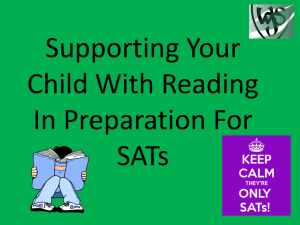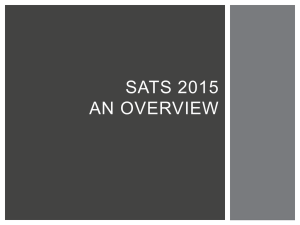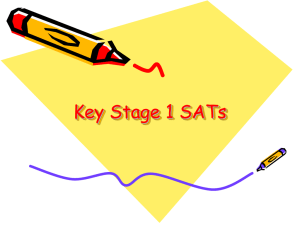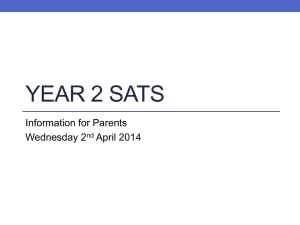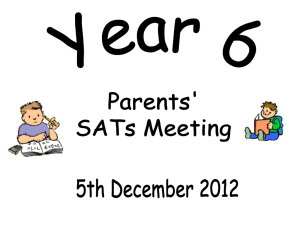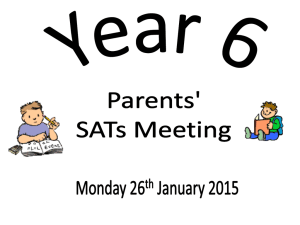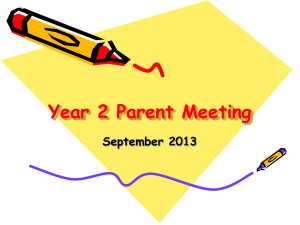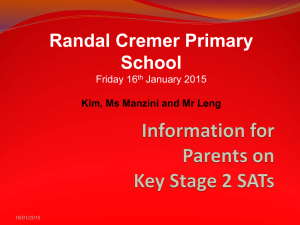Reading SATs - Wickford Junior School
advertisement
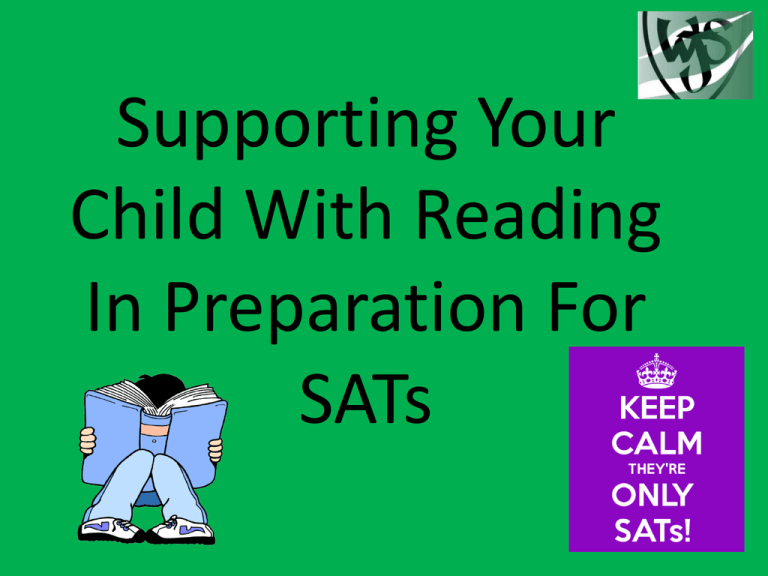
Supporting Your Child With Reading In Preparation For SATs What are SATS? • National Tests taken by all year 6 children • They are taken during the week beginning 12th May 2014 from Monday to Thursday Monday 12th Tuesday 13th Wednesday 14th Thursday 15th SPAG Mental Maths Maths Paper 2 Break Break Break Maths Paper 1 Level 6 Maths 1 8.50 10.00 10.15 Break 10.30 11.30 Reading Comprehension Level 6 SPAG Level 6 Maths 2 12.15 Lunch 1.15 Level 6 Reading Comprehension 2.15 3.15 Lunch Lunch Lunch Arrangements for the week • We run a free breakfast club Monday-Thursday • We give children support in different ways, depending on their needs • We cope with unforeseen circumstances! Assessment focuses • There are seven assessment focuses used to assess children’s reading levels. (There is some overlap between them.) • Each different assessment focus has a different weighting in a SATs paper ; for example, there are more AF2 and AF3 questions than AF7 as they involve more important reading skills. • Children in Year 6 should be familiar with the assessment focuses. We use a “child-friendly” version of them in lessons, beginning with “I can…” • See extract from The Tin Princess by Philip Pullman. AF1 – I can read words using different strategies • This means children can actually work out what the words in the text say (decoding). This is an early reading skill. • The majority of children in Year 6 are secure with this. They no longer need to read out loud in order to show they can decode. • This skill is not tested in a SATs test. • For some children with specific difficulties with reading, they may still need to work. Please check with your child’s class teacher if unsure. AF2 – I can find information in the text to answer questions • This is one of the most important assessment focuses. • This means that children have a general and literal understanding of a text. They can identify the key points and find evidence in the text to support answers: AF2 questions • Where is the characters’ final destination? Find the evidence in the text. • Which character is finding the journey the most difficult? How do you know? • Explain in your own words what is happening. AF3 – I can use clues in the text to “read between the lines” and find out even more information • Again this is a very important assessment focus and usually the one which the children find the most difficult. It is the current Year 6 reading target. • As adults, we can easily identify “hidden meanings” within the text. Children need to be taught to do this. • Children are reading detectives - “looking for clues” in the text to explain what is happening. • To do this, children will need to find evidence in the text to answer the question. They may also use their own experiences to help i.e. using empathy skills. AF3 questions • How do you think Becky is feeling at this point? Find evidence in the text to explain how you know. • Why do you think Becky is helping Adelaide? Explain how you know using evidence from the text. • What do you think will happen next? Find evidence in the text to explain your answer. AF4 – I can explain how the text been organised • This AF has less weighting. • For fiction texts, this usually relates to paragraphing, chronological order and how the organisation affects the reader. • For non-fiction texts, it may refer to use of text boxes, tables, captions, glossary, contents and index etc. AF4 questions • Why has the author started a new paragraph for “Come on…” ? • Why has the author used a one sentence paragraph? • Is the story in chronological order? Explain how you know using evidence from the text. AF5 – I can explain how the writer has used language to affect the reader in different ways • This is important because it has a direct link to children’s choice of vocabulary in their own writing. When children can identify good language and how it affects them as a reader, they can then use it in their own work when they are the writer. AF5 questions • What is the effect of using the word “soothingly”? • Why does the author use … after “a shadow fell across them” ? • Find a really effective sentence and explain its effect on the reader. AF6 – I can explain the writer’s viewpoint and how the whole text makes the reader feel • This AF focus has less weighting. • This involves looking at the text as a whole. • Again, the children will need to find evidence from the text to support their answers. AF6 questions • How do you think the author would like you to feel about Adelaide? Find evidence in the text to support your answer. • What does this text make you feel about the shadow? Find evidence in the text to show how the author makes you feel this. • Give three words to sum up the mood of the text. AF7 – I can compare and contrast stories set in different cultures, places and times. • This has the least weighting of all the AFs. AF7 question • Find a word or phrase that makes you think this is not set in 2013. Children should explain their answers clearly and give evidence from the text where possible. “How do you know?” Opportunity to look at our most recent SATs reading paper, including the assessment focuses of each question. The children are given fifteen minutes reading time, then forty five minutes to answer the question, referring back to the text. Practical ideas – how adults at home can help prepare children for their reading SATS. • Most children in Year 6 do not need to read out loud at home. A better model to use is a “book club”. The child and adult can read an agreed amount of text independently “in their heads” (eg a chapter, two pages) and then discuss, with the adult asking questions relating to the different assessment focuses. • See AF question prompts on handout. • It should be possible to adapt these to suit most texts your child will be reading. Children should explain their answers clearly and give evidence from the text where possible. “How do you know?” • Adult comments in the reading records can then reflect this. Any questions?
